Thursday, April 15, 2010
Perodua sales hit all-time high
Monday, April 12, 2010
Myvi Custom dashboards
Due to popularity demand, DSS Studio has decided to make this service available to all Perodua MyVi owners. Now you can customize your dashboard, making your ride even prettier. Quote code name NICK-DASHBOARD when making inquiries.
Saturday, April 10, 2010
Perodua Viva fuel consumption and monthly installment
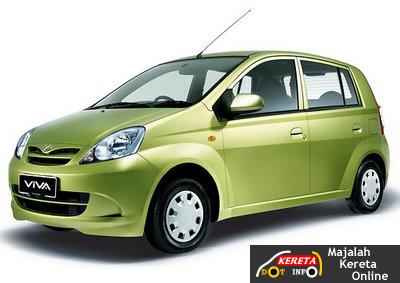
Perodua Viva Fuel Consumption (Penggunaan minyak RM/KM Perodua Viva) :
Viva 1.0 (auto) RM0.1842-RM0.2 per kilometer
Viva 1.0 (Manual) RM0.1458-RM0.157 per kilometer
Viva 850 (manal) RM0.155 per kilometer
Viva 660 (manual) RM0.14-RM0.149 per kilometer
Note: The Perodua Viva Fuel Consumption above is an average value (RM2.7/litre of fuel) of survey around the internet from Perodua Viva Owner. It is a real review by Perodua Viva 660, 850 and 1.0 cc owner.
Perodua Viva Prices
Perodua Viva 660cc MT Solid: RM28,400
Perodua Viva 660cc MT Metallic: RM28,800
Perodua Viva 850cc MT Solid: RM32,500
Perodua Viva 850cc MT Metallic: RM32,900
Perodua Viva 1000cc MT Solid: RM36,800
Perodua Viva 1000cc MT Metallic: RM37,200
Perodua Viva 1000cc AT Solid: RM39,800
Perodua Viva 1000cc AT Metallic: RM40,200
Perodua Viva 1000cc Premium MT Solid: RM40,800
Perodua Viva 1000cc Premium MT Metallic: RM41,200
Perodua Viva 1000cc Premium AT Solid: RM43,800
Perodua Viva 1000cc Premium AT Metallic: RM44,200
Perodua Viva Price On The Road And Monthly Installment Payment:
ViVa 660 EX *S RM 28,400.00 Monthly RM 327.00
ViVa 660 EX *M RM 28,800.00 Monthly RM 333.00
ViVa 850 EX *S RM 32,500.00 Monthly RM 375.00
ViVa 850 EX *M RM 32,900.00 Monthly RM 380.00
ViVa 1.0 SX *S RM 36,800.00 Monthly RM 425.00
ViVa 1.0 SX *M RM 37,200.00 Monthly RM 429.00
ViVa 1.0 SXi *S RM 40,800.00 Monthly RM 471.00
ViVa 1.0 EZ *S RM 39,800.00 Monthly RM 460.00
ViVa 1.0 EZ *M RM 40,200.00 Monthly RM 464.00
ViVa 1.0 EZi *S RM 43,800.00 Monthly RM 506.00
ViVa 1.0 EZi *M RM 44,200.00 Monthly RM 510.00
Note:- *S for Solid colour. *M for Metallic.
Review of Perodua Viva
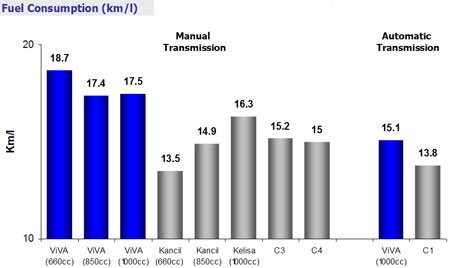

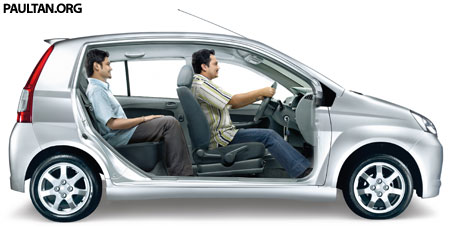
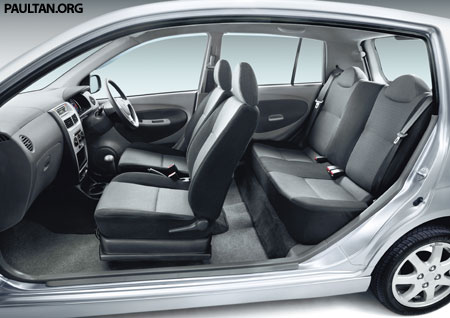

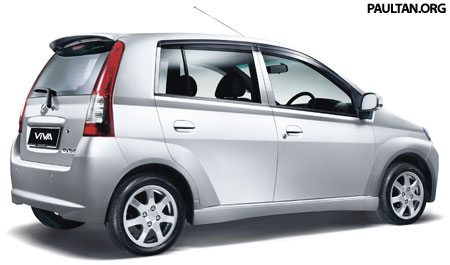
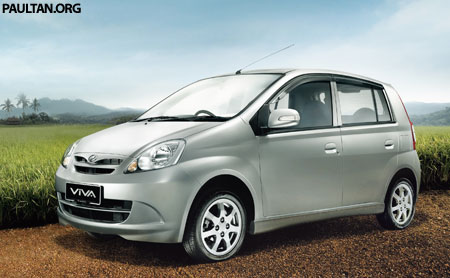
The Perodua Viva is an A-segment car. What will make it a killer is it’s perceived Toyota DNA and the lack of any other viable choices in the A-segment. It seems most typical A-segment buyers have moved up to the B-segment, especially to the Perodua Myvi. Perodua’s A-segment offering is already more than a decade old and the standards of how big an A-segment car should be has pretty much changed. The Kancil has become too small for anyone other than the very poor.
Sales of the Kancil and Kelisa have dropped from the year 2003 onwards, declining steadily from about 100,000 a year in 2003 to only about 60,000 a year in 2006. With the introduction of the Perodua Viva, Perodua intends to change the market perception of it’s A-segment models from SMALL to COMPACT, from CHEAP to AFFORDABLE, and from INFERIOR QUALITY to HIGH QUALITY.
Perodua Viva Interior
Based on the previous generation Daihatsu Mira which has only just been replaced last year, it’s really no secret how the Viva looks like. It was shown at the KLIMS as the Perodua XX06 Concept fully undisguised for everyone to see, albeit having no doors. Inheriting Daihatsu’s K-car expertise, the Perodua Viva shares the Myvi’s space-efficient interior engineering. In terms of interior length, the Perodua Viva is actually longer than the Perodua Myvi, at 1845mm compared to the Perodua Myvi’s 1835mm. This interior length is class leading, with all competitors including it’s own Kancil and Kelisa models having interiors shorter than 1790mm.
As for interior width, it is 1300mm wide, compared to the Myvi’s 1400mm. It’s definitely wider than the Kelisa’s 1220mm and 1185mm. The Perodua Viva has a 149 liter boot capacity with the rear seats up, and this increases to 449 liters with the rear seats down.
It’s four doors open 90 degrees, an improvement over even the Perodua Myvi which has an 80 degree door opening angle, and a big improvement over the Kelisa’s 60 degree door opening angle. There are many storage compartments in the car, other than the usual glovebox, there is a tray located under the passenger seat.
Different Trim Levels
L-R: 660 and 850cc, 1000cc, 1000cc Premium
The Perodua Viva comes in four trim levels – 660cc, 850cc, 1000cc, and 1000cc premium. The Perodua Viva 660cc has trim level that is obviously for cost-saving reasons. Bumpers, door handles, and wing mirrors are material coloured – that usual grayish stuff that’s unpainted. Even the door trim has no fabric. The audio system is a radio and cassette player only, without an option for CD, and there are only front speakers. Wheels are 12 inch steel wheels. Seat covers are specified as “standard grade”, whatever that means. The side and front turn signals are amber lense units. There are no power windows.
The Perodua Viva 850cc takes it up one notch with the door handles and bumpers painted to the body colour, though the door is still without fabric. Wheels are still 12 inch steel wheels, but a full wheel cap is supplied. Power windows are available. Seat cover material is specified as “medium grade”. The audio system is equipped with a CD player and also 4-speakers. It also has powered windows, which means you can adjust it’s angle from within the car through button control, but it does not have a retracting feature. Both the 660cc and 850cc have no power steering!
The Perodua Viva 1000cc adds some nifty features like the under-seat tray, headlamp buzzer warning (in case you leave your car with your headlamp on), seat height adjuster, and most importantly the power steering. The wheels are still steel wheels with full wheel cap covers, but are 13 inch in size. Side and front turn signals are of the clear lens type. The premium version has the usual creature comforts such as electrically retractable side mirrors, a first for a Perodua car. Even the premium Myvi does not have this feature. Other premium feature are the height-adjustable driver’s seat and the vanity mirror on the sun visor.
Of course, the features that are a must for any premium line version of a local car are ABS and dual SRS airbags, available only on the 1000cc Premium trim of the Perodua Viva. The 1000cc Premium has what Perodua calls “High Grade” seats, while the 1000cc standard uses the same medium grade seats as the 850cc.
Other than the different engines, other technical specs you should take note of is the suspension system. All Perodua Viva cars use McPherson struts are the front and a torsion beam setup at the rear, but the 1000cc models have an additional stabilizer bar in front.
Perodua Viva Engines
Powering the Perodua Viva is a range of three engines, which all come with DVVT Variable Valve Timing. Yes, DVVT even for the 660cc and 850cc models. The 660cc EF-VE engine is a high revver, with peak power of 47 horsepower coming in at a high 7,200rpm. The engine readline is an astronomical 8,000rpm (look at the photo of the meter panel below), numbers usually associated with performance cars, but is actually quite typical of small displacement K-car engines. Peak torque of 58Nm arrives at 4,400rpm.
The 850cc engine option is the ED-VE, making slightly higher horsepower than the 660cc at 52 horsepower, however it is achieved at a lower 6,000rpm. Peak torque is also higher and arrives earlier in the rev range – 76Nm at 4,000rpm. The biggest displacement engine is the EJ-VE which we are all familiar with since the Myvi 1.0 liter – 60 horsepower at 6,000rpm and 90Nm of torque achieved at a low 3,600rpm. All cars come with a 5-speed manual gearbox, but the 1000cc models have 4-speed automatic gearboxes.
Here is a table with the claimed fuel consumption figures of the Perodua Viva compared to it’s competitors:
Finally, what everyone’s been waiting for. How much does the Perodua Viva cost?
Perodua Viva Prices
Perodua Viva 660cc MT Solid: RM28,400
Perodua Viva 660cc MT Metallic: RM28,800
Perodua Viva 850cc MT Solid: RM32,500
Perodua Viva 850cc MT Metallic: RM32,900
Perodua Viva 1000cc MT Solid: RM36,800
Perodua Viva 1000cc MT Metallic: RM37,200
Perodua Viva 1000cc AT Solid: RM39,800
Perodua Viva 1000cc AT Metallic: RM40,200
Perodua Viva 1000cc Premium MT Solid: RM40,800
Perodua Viva 1000cc Premium MT Metallic: RM41,200
Perodua Viva 1000cc Premium AT Solid: RM43,800
Perodua Viva 1000cc Premium AT Metallic: RM44,200
The baseline Viva is about 6k more expensive than the cheapest Perodua Kancil 660EX Manual with solid colour. However perhaps this price is justified considering you get alot more interior space as well as a much more modern engine – the Kancil only has a carburetted engine making 31 horsepower. Besides, Perodua has decided to keep the Kancil in production, which means the Viva is technically a Kelisa Replacement Model. If you’re on an ultra-low budget, the Kancil is still the car for you I suppose.
The Perodua Viva comes with a 3 year manufacturer warranty.
Myvi vs Viva
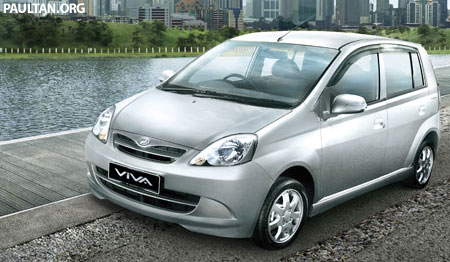
Below is what I get in my research of Perodua Myvi VS Perodua Viva :
We can assume if you buy a Perodua, you’re most likely going to be a very price-sensitive person. If you haven’t read my previous comparison of the Perodua Myvi and Perodua Viva, please click here to read it first. This blog entry focuses on the financial details if you buy a Perodua Viva or a Perodua Myvi.
First, we look at how much the car would cost in monthly repayments over a period of 3, 5 or 7 years assuming a 10% downpayment and 3.88% interest rate. The two variants of the Viva and Myvi I am using here are the Perodua Viva 1000cc Premium with Airbags and ABS, and the Perodua Myvi 1.3 liter Premium with Airbags and ABS. Both are of the automatic transmission variant with metallic paint.
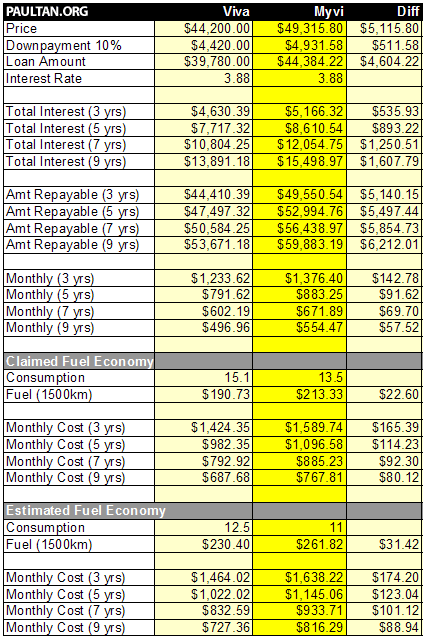
First, let’s look at how much the two cars cost monthly. Over a 5-year loan which is what most people would take, the difference in monthly repayment between the Viva and the Myvi is about RM91.62 a month, or RM1099.44 a year. Over a 7-year loan, it is RM69.70 a month – or RM836.40 a year. If you think of it in monthly terms, an extra RM91.62 a month gets you an upgrade from A-segment to B-segment, more interior width so the rear bench is more comfortable with 3 people seated, and a smoother 4-cylinder engine that makes more power, together with a better power to weight ratio.
But let’s not forget what upgrading to a bigger 1.3 liter 4-cylinder engine will do – increase your fuel consumption. For this one, it’s a little bit tricky. We’ve got two different km per liter figures to play with – Perodua’s optimum situation claims as well as estimated real life scenarios for the Viva, as well as the average reported fuel consumption for the Myvi from the Myvi owners I’ve asked. We also assume a traveling distance of 1500km a month (50km to and fro work daily, times 30 to factor for other misc traveling during weekdays and weekends), and the current RON97 petrol price of RM1.92 per liter.
Using the optimum fuel consumption calculation – you’ll save RM22.60 a month driving the Viva compared to driving a Perodua Myvi. Using the estimated real life scenario fuel consumption calculation, you’ll save RM31.42 a month. This brings the the amount you have to fork out every month for a Viva to RM1,022.02 a month inclusive of 5-year loan monthly installment and fuel expenditure, and for the Myvi – RM1,145.06. Damn, even though these are supposed to be affordable, these cars are looking pretty expensive to run now. The difference between the Myvi and Viva for a 5-year loan in this case is RM123.04, or RM1476.48 a year.
This is of course, a calculation for the first year where your road tax and insurance premium has already been covered in the purchase price. But let’s just keep things simple for the moment. The Myvi has a higher insured value and a larger engine, thus the two items will be more expensive, further widening that RM123.04 gap but it won’t be too big a difference. In terms of percentage, it’s about a 12 percent difference.
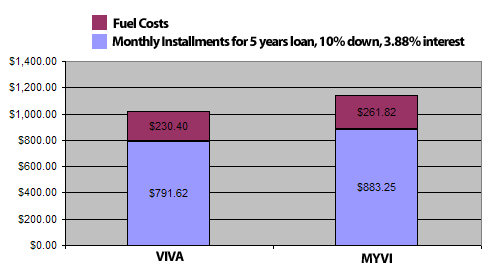
What’s RM123.04, or a savings of 12 percent worth to you? Is it worth the upgrade from the Viva to a Myvi? I’m not here to decide for you, just presenting to you the figures so you can decide for yourself.




